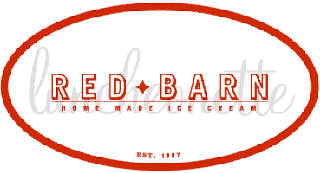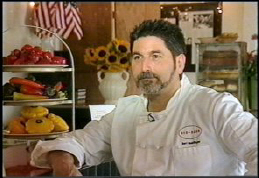 |
 |
 |
| home | menues | directions | hours | press |
|
|
THE LESSON: Succeeding in a new business can mean abandoning skills that
worked the first time around
By KATHRYN KRANHOLD
Just three months after New York City dentist Bert Goldfinger bought the Red Barn restaurant in upstate New York, a freezer holding more than 60 gallons of homemade ice cream broke down. Without the freezer, called the hardening container, Dr. Goldfinger couldn't make the eatery's trademark dessert for the coming Labor Day weekend. That was one of the budding chef's first signs that running a restaurant would be a markedly different experience from operating his orderly Manhattan dental practice. Later that same week in 2001, Dr. Goldfinger had to remove part of a recently renovated back wall of the 100-year-old converted barn to make room for his new $10,000 freezer. He has since replaced most of the major equipment and installed commercial stoves and a wall-mounted potato slicer. With his wife and business partner, Chris Jones, Dr. Goldfinger has turned what was once a rundown ice-cream and hot-dog joint into a country bistro with fare ranging from local delicacies like fiddlehead ferns and shad roe to standards such as New York strip steaks, New England lobster rolls, meatloaf and hot turkey sandwiches. Juggling Act The story of how one businessman goes from treating teeth four days a week to weekends of peeling 500 pounds of potatoes is one of a juggling act in management skills. What worked in his old world is often useless in his new one: His new playbook calls for managing teenagers instead of a seasoned staff, and catering to a fickle culinary clientele. "As a doctor, I'm treated with a certain level of respect. Patients generally will follow what I tell them to do," says the 52-year-old Dr. Goldfinger. "In the restaurant, you're only as good as your last meal." The Red Barn, two hours north of Manhattan in the small town of Ghent, serves meals Thursday night through Sunday evening in the summer. During the winter, it is open Friday night through Sunday brunch. Dr. Goldfinger often arrives at the restaurant on Thursday a few hours before he starts cooking, having seen his last patient either late Wednesday or early Thursday. By the time he gets to the restaurant, he has stocked up on specialties from the city such as cheese or oils, and has ordered the vegetables, fish and meat he plans to serve for the next few days. He buys about 80% of food locally; his seafood comes in fresh from Boston.
Meanwhile, Ms. Jones, a veteran advertising and marketing executive, bakes, makes the ice cream, and runs the front of the restaurant, serving as host and handling reservations. She also takes on other less glamorous projects, like mopping the floors. "I didn't think about all the negatives," she says. "There are plenty." That said, Ms. Jones, now vice president of business development for Russell Design Associates, a graphics design firm in Manhattan, has complete confidence in her husband, who has been the driving force for the restaurant. "He's really talented at what he's doing," she says. The American public's romance with food and restaurants has never been greater, as evidenced by the popularity of shows like "America's Test Kitchen" on public television and last season's NBC reality show "The Restaurant," about the opening and running of a restaurant in Manhattan. But most restaurateur wannabes quickly discover the unromantic truth: It's a tough business with long hours. And while many entrepreneurs have tried to open restaurants, few survive. Restaurateur Drew Nieporent, president of Myriad Restaurant Group, which owns Tribeca Grill and Nobu in downtown Manhattan and Rubicon in San Francisco, says opening a restaurant today is more difficult than ever. "The supply seems to outstrip the demand," says Mr. Nieporent, who offers weekend seminars on opening a restaurant that Dr. Goldfinger and Ms. Jones attended. Mr. Nieporent says he has discouraged some people from opening a restaurant. For example, one wannabe restaurateur proposed spending more than a million dollars on a small space with not enough tables to support the investment. "Sometimes it's a little cockamamie," he says. Back to School For Dr. Goldfinger, the culinary arts have long been a passion, and he put himself through dental school working in a catering business. In 1996, after practicing dentistry for nearly 20 years, he enrolled at the French Culinary Institute, in Manhattan, and attended night classes for nine months. He took top honors in his class for designing a seven-course meal around a potato. For one dish, he made a three-color potato soup -- white, purple and orange. His dental skills came in handy as he carved a potato to look like a mushroom for a salad. He also made a purple potato risotto with rack of lamb and a sweet-potato soufflé for dessert. He says he was inspired by his teenage stepdaughter, who would eat only potatoes at the time. Soon Dr. Goldfinger was working evenings and weekends at the elbows of celebrity chefs like Aureole's Charlie Palmer and Le Cirque 2000's former pastry chef, Jacques Torres. He spent two years at Le Cirque 2000, starting in the pastry division and then working through the other stations of a kitchen, including as the garde manger, responsible for the cold foods, and as line cook under former executive chef Sottha Khunn. Although owning his own restaurant was still in the distance, Dr. Goldfinger lined up outside the St. Moritz Hotel in Manhattan for a liquidation sale in January 2000. Unlike most of the crowd that day, he wasn't interested in the hotel's artwork and furnishings, but instead was scouting the giant stockpots and sauté pans. Drawing on the patience he learned over the years running his dental practice, Dr. Goldfinger returned each day during his lunch hour until he negotiated a lower price. Still, financing a restaurant was different from funding his dental practice. When he finished dental school, Dr. Goldfinger recalls, he had plenty of access to financing for his new practice because he was a doctor. Not so with the Red Barn, where bankers wanted to see a detailed business plan. To figure out how to write one, Dr. Goldfinger took restaurant management and finance classes at New York University and the New School in Manhattan. One class taught him how to organize a menu with a mix of dishes in a low-to-high-price range and what that variety means to profits. For example, a grilled-cheese sandwich, which costs only a dollar to make and sells for $5, has a gross profit margin of 80%, while a steak that costs $10 and sells for $25 has a lower profit margin but brings in much more money. Ice Cream U. To further his know-how, Dr. Goldfinger also went to Ice Cream University, a New York-based consulting firm for ice-cream businesses that offers weekend seminars. And Ms. Jones took a bread-making course at the French Culinary Institute. From the start, it was apparent that the restaurant was not going to hum along like his dental practice on the city's Upper East Side. In offices shared with his onetime dental-school classmates, he and his office manager, Lucia, and his dental hygienist, Jennifer, have a long-established routine. Mouth mirrors, pliers, spatulas, scalpels are neatly stored in rows of drawers; the Food Network, or the news, is tuned in quietly and at eye level for patients. At the Red Barn, the staff is mostly young, and availability is determined by athletic events, dating and homework. Employees don't always know the difference between foods. (One waitress referred to shad roe as "chad roe.") A radio blares in the background, against the sounds of clanking plates and sizzling beef. Stained copies of "The Professional Pastry Chef," "Cook's Illustrated: the Best Recipe" and a James Peterson book on fish and shellfish are stacked in no particular order on one shelf. Guessing Game Ordering supplies offered another challenge. At Dr. Goldfinger's dental practice, his sterilized tools and materials have a long shelf life, and he can easily order what he will need for his scheduled patients. But there is no telling of people's tastes, and Dr. Goldfinger runs the risk of ordering too much of specific entrees, such as seafood or beef. One recent weekend, he sold only six of 30 portions of soft-shell crabs. The next weekend, he cut back his order, buying what amounted to 24 entrees. They sold out immediately. "Even now I can't always predict what sells," he says. Dr. Goldfinger follows a few basic guidelines, like the "economy of the duck," preached by one of his teachers, television personality and cookbook author Jacques Pepin. It means that the chef uses every part for something. In his case, Dr. Goldfinger says, "If I order too much meat, I can use it for chili. If I order too much chicken, I can use it for chicken stock." Taking reservations is also an art compared with scheduling patients where given amounts of time are allotted for certain procedures. When the restaurant first opened, Ms. Jones says she was so excited about the number of customers calling for tables that she overbooked. "Early on, I had too many people," she says. "We didn't know how to do any of this." Dr. Goldfinger and Ms. Jones still haven't veered much from their basic business plan, with a few exceptions. Their takeout business hasn't taken off yet, and they dropped plans to stay open six or seven nights a week because they couldn't hire dependable help to prepare and serve the food. But the restaurant broke even after 2½ years and now is profitable. To prepare for their fourth season, Dr. Goldfinger and Ms. Jones closed the Red Barn this past winter for two months. They made repairs on the building and added a bar for their coming liquor license. They also took time to eat out and study menus. When they reopened in April, they added a few items to their menu, including a Cuban sandwich, cheese fondue and several smaller appetizer plates. They stopped serving the retro dollop of mayonnaise on a piece of lettuce with a slice of tomato. Dr. Goldfinger says bluntly: "It made me sick to look at it." Now they serve a simple slice of vine-ripened tomato with certain entrees. The restaurant has a following of local residents and weekenders, and patrons include photographer William Wegman and TV personality Al Roker, who featured Dr. Goldfinger on his Food Network show. Ms. Jones has used her marketing skills as well. She writes the Red Barn Blog (theredbarn.typepad.com/the_red_barn_blog3), an online journal where she keeps regulars up-to-date on what is being served (ramps, lobster roll, banana and strawberry ice cream, for starters) and chronicles the trials and tribulations of running a restaurant. When they were forced to shut down the restaurant one weekend, Ms. Jones wrote: "Bert was very upset...especially when he saw the cars pulling in and out of the parking lot after they read the 'We're closed due to a broken pump' sign. I had all I could do to keep him from jumping off the roof of the walk-in [refrigerator]. Definitely not high enough to do the trick." Despite the headaches, there is an obvious upside. Dr. Goldfinger says: "People look forward to coming here. They would rather be here than at the dentist." Ms. Kranhold is a staff reporter in The Wall Street Journal's New York bureau |